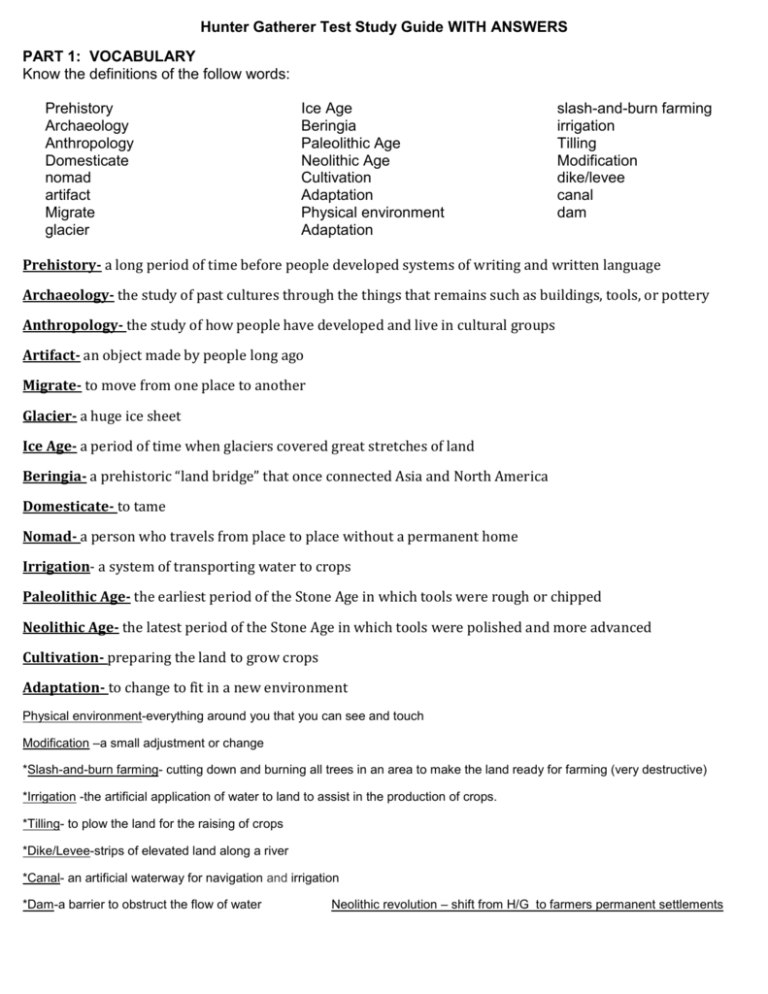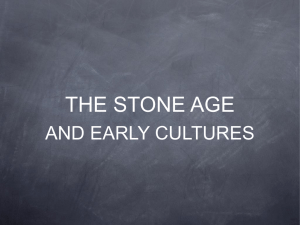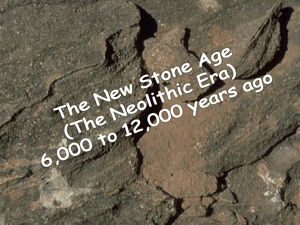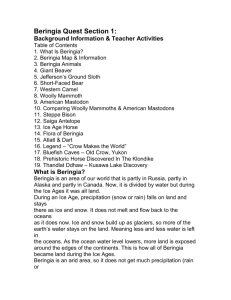Hunter Gatherer Test Study Guide WITH ANSWERS PART 1
advertisement

Hunter Gatherer Test Study Guide WITH ANSWERS PART 1: VOCABULARY Know the definitions of the follow words: Prehistory Archaeology Anthropology Domesticate nomad artifact Migrate glacier Ice Age Beringia Paleolithic Age Neolithic Age Cultivation Adaptation Physical environment Adaptation slash-and-burn farming irrigation Tilling Modification dike/levee canal dam Prehistory- a long period of time before people developed systems of writing and written language Archaeology- the study of past cultures through the things that remains such as buildings, tools, or pottery Anthropology- the study of how people have developed and live in cultural groups Artifact- an object made by people long ago Migrate- to move from one place to another Glacier- a huge ice sheet Ice Age- a period of time when glaciers covered great stretches of land Beringia- a prehistoric “land bridge” that once connected Asia and North America Domesticate- to tame Nomad- a person who travels from place to place without a permanent home Irrigation- a system of transporting water to crops Paleolithic Age- the earliest period of the Stone Age in which tools were rough or chipped Neolithic Age- the latest period of the Stone Age in which tools were polished and more advanced Cultivation- preparing the land to grow crops Adaptation- to change to fit in a new environment Physical environment-everything around you that you can see and touch Modification –a small adjustment or change *Slash-and-burn farming- cutting down and burning all trees in an area to make the land ready for farming (very destructive) *Irrigation -the artificial application of water to land to assist in the production of crops. *Tilling- to plow the land for the raising of crops *Dike/Levee-strips of elevated land along a river *Canal- an artificial waterway for navigation and irrigation *Dam-a barrier to obstruct the flow of water Neolithic revolution – shift from H/G to farmers permanent settlements PART 2: Answer the following questions The differences between primary and secondary sources: Primary source- first hand account, original document Secondary source- second-hand account How do archaeologists learn about prehistoric people? Through the study of artifacts What are some examples of artifacts of early people? Tools, weapons, pottery, jewelry How do archaeologists think early man got to North America? Migrated across Beringia Why would Stone Age man domesticate animals? To tame them for their use, provide food, labor, clothing How did plant and animal domestication affect village or community life? People had more food What did surplus food lead to during the Stone Age? Population growth and civilizations What are the characteristics of good farm land? Fertile soil, fresh water, easily defended, transportation for trade, flat land, warm climate What do cave paintings of early man reveal to us? Early man painted their lives in pictures. Who was Otzi? Neolithic herder who was found in a glacier. How did glaciers contribute to the development of agricultural societies? Ice Age ended, temperature of the Earth warmed up, causing glaciers to melt, rivers formed, fertile, rich soil was deposited. What are two results of farming? More food for more people, need more people to work Why do scientists believe the Ice Ages occurred? Scientists believe there are two explanations of why the ice ages might have occurred. They believe temperatures were much colder so it never rained, only snowed, or the earth changed its tilt away from the sun. What did the Earth look like during an Ice Age? During an Ice Age the land looks very different. The Earth was frozen and bare. When the land and temperatures are this barren and cold, the biome is called the tundra. Because the weather is so cold and the ground is frozen, very few plants can exit. The only trees that grew were evergreens. No grass or flowers grew just shrubs, bushes, and moss grass. In the northern parts of North America, Europe, and Asia there is still tundra. What does the term Neolithic Revolution refer to? The transition from hunger-gatherer societies to agricultural societies RACE= R- restate A-answer C-cite E-expand










